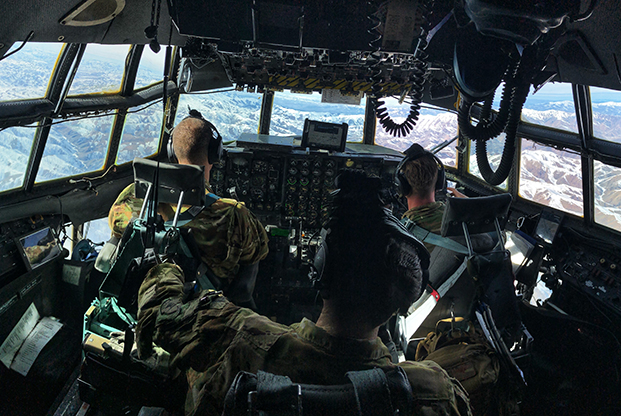
A USAF aircrew pilots an Afghan C-130 as part of the Train Advise and Assist Command's mission on Dec. 19, 2018, in Kabul, Afghanistan. Air Force photo by SrA. Maygan Straight.
As US drawdown plans take shape, the Pentagon’s leaders in Africa and the Middle East emphasized their partnerships with local air forces in congressional testimony Thursday.
The Afghan military, including its air force, still depends on international partners and mentors to hold off and reclaim territory from the Taliban, Army Gen. Joseph Votel, the leader of US Central Command, told the House Armed Services Committee.
Although US and Taliban negotiators are discussing removing US troops from Afghanistan as a condition of a future peace agreement, “political conditions and where we are in the reconciliation right now don’t merit” a withdrawal, Votel said. He stressed he has not yet received orders to draw down.
“These decisions have to be based more on conditions than on specific times,” he said. “Any decision to reduce forces in Afghanistan should be done in full consultation with our coalition partners and, of course, the government of Afghanistan, and should pivot off political progress in the reconciliation process.”
Modernizing Afghanistan’s air force is a multibillion-dollar project spanning more than 300 new aircraft and an updated maintenance enterprise, with more work to be done to ensure those security forces can stand on their own against the Taliban, local affiliates of the Islamic State of Iraq and Syria, and other organizations.
In contrast, Votel expressed confidence in Iraq’s military leadership at a time when that nation’s troops will play a pivotal role in suppressing ISIS’s resurgence in the area.
Partner nations can also host US assets at local bases and offer medical, training, maintenance, and logistical support that complements American assistance, the outgoing four-star told lawmakers. He pointed to Oman, a “bastion of stability” that provides “crucial access” for aircraft to pass through and land, as well as for ships to load and unload cargo and refuel.
In his own written testimony, US Africa Command Gen. Thomas Waldhauser provided an overview of ongoing work to expand the capabilities of air forces across the continent.
Senior leaders from 28 African nations as well as US Air Forces in Africa and US Air Forces Africa convened in October at the eighth annual African Air Chiefs Symposium, “a forum to discuss common defense issues, increase cooperation, and improve command and control of air operations,” according to Waldhauser’s testimony.
AFAFRICA flew “proof-of-principle” missions with the Tunisian air force as it works to “leverage their transport capability for rapid mobility requirements across the theater,” Waldhauser said.
“Continued flights over time will serve as an opportunity to enhance the capability of the Tunisian air force, while reducing the stress on US airlift assets and personnel.”
He also noted an exercise held with the Royal Moroccan Navy and Air Force last April marked the “most sophisticated bilateral exercise” conducted with an African partner.
While Tunisia can handle advanced logistics training and “increasingly complex” intelligence, reconnaissance, and surveillance assets, Waldhauser said, the Nigerian Air Force will work with AFRICOM on “tailored programs” to improve its ISR, counter-improvised explosive device, and air-ground integration capabilities.
Over the next 18 months, AFRICOM will start to pull about 10 percent of its 7,200 members out of Africa, including both conventional and special-operations forces “in areas where their work is pretty much done,” the Pentagon’s Africa chief said. The Defense Department said last November the full reduction will take several years.
“Optimization on the African continent has to do with counterterrorism strategy only,” Waldhauser said. “It’s a very small niche,” but it’s “difficult to get into numbers because they move around all the time.”
Part of the Air Force’s plan to help other militaries combat the rise of terror groups in the Middle East and Africa relied on its light-attack experiment, which promised to find an affordable turboprop attack aircraft that could also conduct ISR missions. But the future of that program – thought to be headed toward production this year – is now unclear because the Air Force wants to broaden its requirements to satisfy partner nations.
Following the hearing, HASC Ranking Member Mac Thornberry (R-Tex.) told Air Force Magazine the committee has yet to hear the rationale for changing the light-attack program.
“I think there are a lot of questions that come from that,” he said.